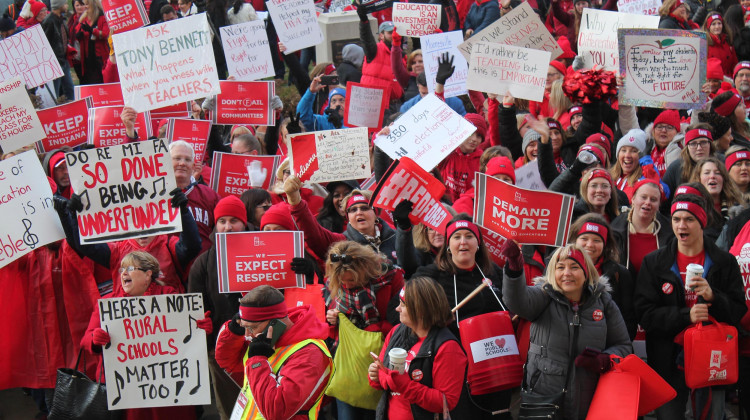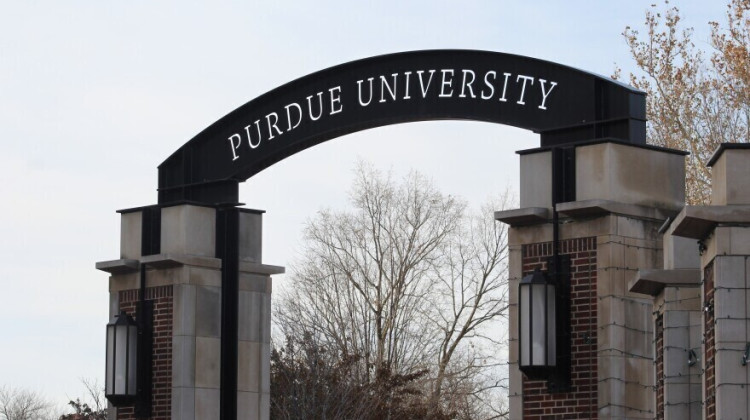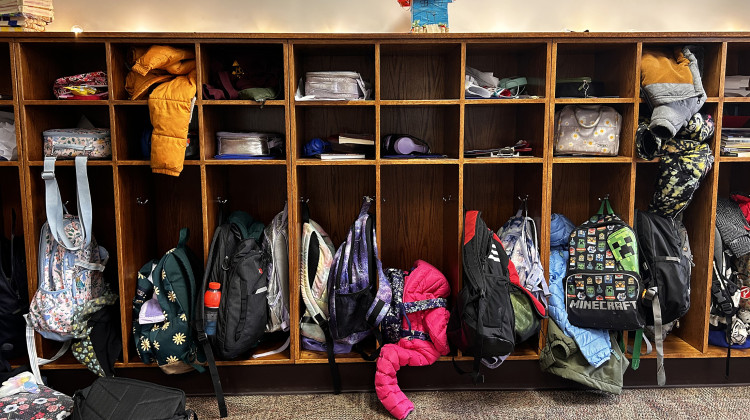
The aging twin boiler system at Jim Hill High School in Jackson, Miss., is photographed Jan. 12, 2023. A litany of infrastructure issues in the nearly 60-year-old school and others like it, make for tough choices on spending COVID recovery funds on infrastructure or academics.
Rogelio V. Solis / AP PhotoIndiana schools could get more time to use hundreds of millions in federal pandemic dollars.
Local school officials face a January deadline to spend what remains of the state’s $2.9 billion aid package for COVID-related projects. But they can request an extension from the U.S. Department of Education to spend money on contracted work through March 2026.
Schools need the extra time because of the program’s tight turnaround time, the large amount of one-time funding, supply chain issues, and bureaucratic processes.
These combined to result in project and reimbursement delays. The federal deadline waiver, if granted to Indiana, would ease some of that pressure.
The Elementary and Secondary School Emergency Relief Fund, or ESSER, is a federal program that pumped $189.5 billion into schools across the country to address the significant disruptions experienced by students due to the pandemic. The money was used for myriad challenges, from learning loss and chronic absenteeism to classroom and building infrastructure projects. The funding came in three waves of legislation passed by Congress from 2020 to 2021.
Now, the vast majority of the funds Indiana schools have yet to spend came from the last part of the American Rescue Plan Act (ARP). Congress set a Sept. 30 deadline for schools to obligate how it will be spent — such as signing contracts for construction or a mental health service provider. The funds could be forfeited if the dollars are not spent by the January deadline or an extension is granted.
Though Indiana’s districts appear to be in a good position to qualify for extensions: 100 percent of their funds are planned to be spent, said Molly Williams, a spokesperson for the Indiana education department.
But Williams said they cannot use the money to pay salary for teachers, counselors, and other staff through ESSER beyond the end of the month. Instead, schools will need to find other funding sources or end those positions.
Last month the state requested its own 14-month extension from the U.S. Department of Education for its own funds. If approved, this would allow the state to keep using pandemic funds to close out the program.
How schools spend ESSER
In early 2022 the state created a dashboard to increase transparency on how the federal funds are spent. Today, it appears to show $300 million is still sitting on the table. That’s about 10 percent of the total allocated to Indiana.
But at least four of the school districts with the greatest portion of their funding marked unspent told WFYI the state’s dashboard doesn’t reflect their district’s spending.
“IDOE’s ESSER Dashboard reflects reimbursement claims processed by IDOE to date and may not reflect actual expenditures,” said Williams, the department spokesperson. “Schools must expend funds locally prior to requesting reimbursement from IDOE.”
South Montgomery Community Schools is the public school district with the greatest portion of unspent funds, according to state data: $1.9 million, or nearly two thirds, of their allocated funding. Superintendent Stephanie Hofer wrote in an email to WFYI that the district’s plans are moving on schedule.
“We absolutely will have all our money spent and definitely do not have money hanging out there,” she said.
Greenfield-Central Community Schools seemingly has nearly the same percentage of remaining funding unspent, according to state data. Superintendent Harold Olin told WFYI that the dashboard hasn’t been updated.
“The ESSER dollars have been spent for a long time,” he wrote in an email. “No school or government entity wants to leave money on the table.”
“Goshen Schools has spent most of the ESSER funding and will have fully spent the grant by the deadline,” wrote Bob Evans, Goshen Community Schools’s chief financial officer. “The delay is with our reimbursements.”
The federal government released the massive aid packages in an effort to minimize negative impacts to students’ learning as districts faced an uncertain outlook in the newly-developing pandemic. The three waves of funding packages were one-time bursts of cash.
But school officials had to balance spending millions without relying on the funds for ongoing expenses, or those that would continue past the funding’s expiration dates. This kind of expense could look like hiring additional staff such as teachers, tutors, mental health counselors, or instructional aides.
And districts have to pony up the cash first: “For all federal funds, districts expend from their own budgets and then seek reimbursement from IDOE,” said Williams.
“Any time you get one-time funds, the possibility of a fiscal cliff exists,” said J. Scott Bowling, the executive director of the Indiana Association of School Business Officials. He was previously the superintendent of Crawfordsville Community School Corporation.
Some school districts were able to find new funding sources for popular programs or support services. Greenfield Central qualified for a federal mental health grant, so they were able to move some mental health professionals off of ESSER and redirect the one-time funds to construction.
Pike Township Metropolitan School District in Marion County wanted to continue with learning loss programs and keep teachers, staff and support services funded by ESSER. They put a referendum to residents that passed by 58 percent of the vote.
Bowling, of the school business officials’ association, said that ESSER really exposed that schools were under-resourced in student mental health services. Schools that chose to address this found those services effective.
But if schools do not find alternative funding for these positions by the obligation deadline, they will no longer be able to support them through ESSER.
“I think that by the time the dust settles — finally settles on the entire program — schools will have spent the vast majority of the ESSER dollars they were allocated,” Bowling said.
School districts budgeted about 44 percent of their funds for instruction, according to state data, and about 18 percent for support services. Districts budgeted about a third of funds for facilities and operations expenses.
Spending on infrastructure
The federal funding could also be used to improve air quality and other infrastructure, though. Close proximity to others could spread the coronavirus through water droplets in the air. This led many districts to opt for the one-time expenses of construction, maintenance or facility projects with hopes of returning students to safer brick and mortar schools.
As demand for infrastructure projects like improving air quality or replacing boilers and chillers increased, school officials said that they faced supply-chain and infrastructure labor shortages, pushing timelines back as they waited their turn.
Superintendent Wesley Hammond of Eminence Community Schools in Morgan County said his district looked into a number of infrastructure projects early on and were told that the wait for a boiler was six months to a year.
Eminence is one of the smallest districts in the state with only 272 students total in the 2023-24 school year. The district qualified for only $624,492 in ESSER funding and the state’s portal showed half of the funds are still not reimbursed.
Hammond said Eminence didn’t initially have the capabilities for virtual schooling, so they purchased technology. Since they couldn’t fill an ESSER-funded learning loss teacher position, they were able to redirect those funds toward other needs. They replaced two old boilers that were installed when the building was constructed and are working on HVAC improvements.
Greenfield-Central Community Schools also opted for some infrastructure projects, including expanding the size of the cafeteria, replacing a chiller, and new air quality equipment. Business manager Nathaniel Day said that his district’s projects didn’t encounter supply-chain delays or labor shortages, but he was aware that other districts did.
“They may be pushing towards the end to get that project wrapped up this summer, even though they really wanted to do it two summers ago,” he said.
The bureaucratic process
In January, the U.S. Department of Education sent guidance to states on deadline extension requests for the final wave of funding, explaining that it would be similar to the process for requesting extensions for the first two rounds of funding.
The state education department’s request for a deadline extension of its own allocated pandemic administrative funds includes a suite of federal funding provisions beyond ESSER, including ESSER’s private school counterpart, the Emergency Assistance to Nonpublic Schools (EANS), Homeless Children and Youth from ARP and several other student support programs.
Indiana formally requested these waivers under the General Education Provisions Act in a late August letter from Tracy Brown, the department’s chief administrative officer.
School districts are still on the hook for applying for their own liquidation extensions — they are separate from the state’s request for a waiver for administrative funds.
“For all federal funds, districts expend from their own budgets and then seek reimbursement from IDOE,” wrote Williams, a spokesperson for Indiana’s education department.
Frank Chiki, the state’s Director of Title Grants and Support, wrote to school administrators in May to explain that the department would submit requests from districts, but only certain activities would be covered: HVAC or similar contracts, construction and renovation contracts, for materials slated to arrive after the original December deadline, professional development registrations and instructional services contracts.
Payroll and travel expenses do not count, he said, since they are obligated when the work is completed — which means they can only qualify for reimbursement up to the obligation deadline on September 30. And that cannot be extended.
After a district submits its request, the federal department’s review and approval process could take 3-4 weeks, according to a U.S. DOE presentation on ARP liquidation requests.
If they’ve obligated their funds by the end of this month, districts can request waivers up to December 30, according to the state. The federal government asked that states and school districts submit their requests together.
Indiana qualified for liquidation extensions in the first two rounds of ESSER funding, according to the U.S. Department of Education.
It seems likely that Indiana’s request will be approved. The federal government approved 12 requests for ESSER I, 26 for ESSER II and three for the final round, according to a department spokesperson.
“The Department approves all liquidation requests for timely, valid obligations that are submitted with complete applications,” said the spokesperson.
Contact data journalist Zak Cassel at zcassel@wfyi.org.
 DONATE
DONATE






 Support WFYI. We can't do it without you.
Support WFYI. We can't do it without you.